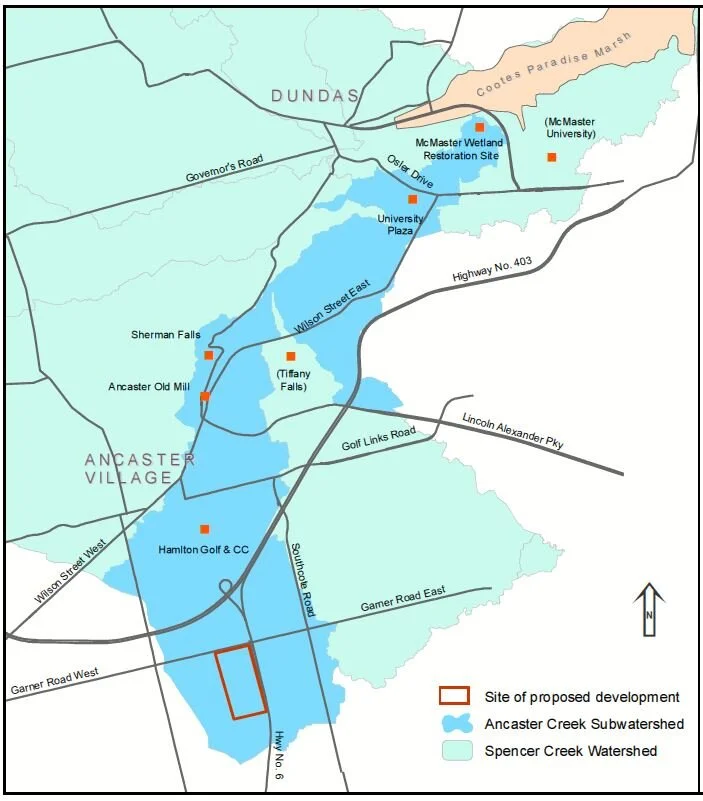Ancaster wetland not safe yet
Climate and community groups are celebrating a stunning environmental victory on Garner Road, but thanks to the Doug Ford government the fate of an Ancaster wetland and headwaters stream remains in jeopardy. The Hamilton Conservation Authority board has turned down a developer request to relocate these aquatic features to make way for construction of five warehouses.
The board spent more than an hour and a half in camera before announcing the decision, so it seems unlikely the vote was unanimous. Prior to the secret vote, they heard from seven citizen delegations and then spent two hours in the formal Section 28 hearing that is restricted to professional staff, the development applicants and the board members.
The surprise decision came despite the absence of the most vocal opponent of the relocation. Councillor Brad Clark, who has been fighting attempts to establish an HCA policy allowing ‘offsetting’ of natural features, was unable to participate in the special Section 28 hearing because of a conflict of interest involving his son. It is unheard of for the HCA Board to completely reject an application after a Section 28 hearing.
All the citizen delegations and 200 letters to the board opposed the application to “slide over” the stream and the Garner Road marsh to a new location adjacent to Highway 6. These public objections bolstered the staff report submitted by HCA deputy-director Scott Peck who contended that the application violated HCA policy. Peck presented during the hearing and gave his professional response to key claims by the developer’s environmental consultant.
Those claims included that the marsh is doomed to be overrun by the invasive phragmites weed, and that the new wetland would be better because it would include an open water pond. In response, Peck noted that the Conservation Authority and others successfully control phragmites on HCA-owned lands, and that introducing an open water pond to the Ancaster Creek headwaters would harm its rare coldwater status (that has earned it the alternative moniker of Coldwater Creek).
The developers do have appeal options that were increased by Ford government legislation last fall that sharply weakened Conservation Authorities. But the huge public outcry against the destruction of a marsh and parts of the Ancaster Creek headwaters will make a reversal of the HCA decision politically costly with a provincial election less than a year away.
Prior to passing of Bill 229 last December, an appeal had to be filed within 30 days and could only go to the provincial Minister of Natural Resources and Forestry where Conservation Authority decisions were rarely overturned. However the new rules, like so many of the Ford government changes, are much more helpful to landowners.
The developers now have up to 120 days to launch an appeal, and it can go either to the Minister or to the Local Planning Appeal Tribunal (LPAT). The Minister is also now able to decide on a permit directly without involvement of the local Conservation Authority.
It would appear that the developers also have another option – to ask for a Ministerial Zoning Order whereby the provincial government would override all the planning rules and any requirements for a public process. Earlier this year a legal challenge to this option was launched against a provincial MZO to allow an Amazon warehouse on top of a provincially significant wetland in Pickering. In response the Ford government passed new legislation to retroactively exempt MZOs from the laws on which the legal challenge was based.
And it was clear in last week’s HCA hearing that the developers are legally able to build around the marsh as long as they ensure a buffer zone. While this would technically preserve the wetland, its resulting isolation among several large buildings and massive parking lots would certainly degrade it and restrict its use by wildlife. Opposing groups including Hamilton 350 Committee, Action 13 and Stop Sprawl Hamilton have vowed to continue working to protect the marsh and headwaters stream.
Other opponents who spoke at the HCA meeting included a representative of the Hamilton Naturalists’ Club, and the family who farm the adjacent land and operate the iconic Ancaster Pumpkin Patch on part of it. In addition, a McMaster faculty member described the wetland restoration work planned for University land near the mouth of Ancaster Creek.



